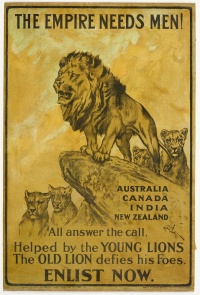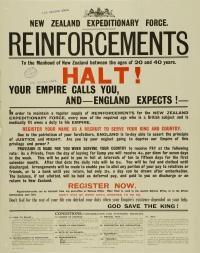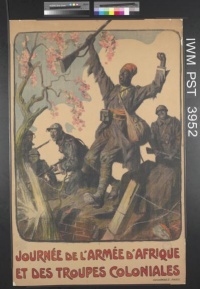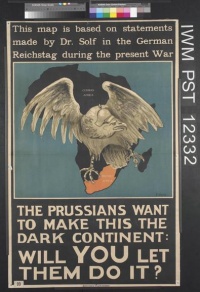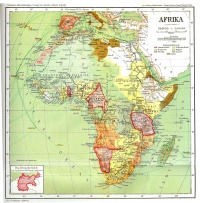A War of Empires↑
For centuries before 1914, the history of the world had been a history of empires, a history marked by imperial exploration, conquest, and incorporation of overseas and overland territories into expansive imperial domains. The decades that preceded the outbreak of the First World War saw that imperial world order expand even more, as new entrants, including the United States, Japan, and Germany, pursued their own spheres of colonial domination amid the far-flung possessions of older empires. Thus, on the eve of the war, much of the landmass of the inhabited world had been carved up into formal empires or semi-colonial territories.
The First World War, therefore, was a war of empires, fought by empires and, significantly, for the protection and expansion of imperial power. The conflict began as a crisis in one empire, with the assassination on 28 June 1914 of Franz Ferdinand, Archduke of Austria-Este (1863-1914), heir to the Habsburg throne, that had long ruled over a vast, multiethnic imperium at the heart of Europe. Within weeks, several more empires – Russia, Germany, France, Britain, and Japan – joined the fray and, not long after, so did the Ottoman Empire. Italy and Portugal, each with their own colonies in Africa, entered the war in 1915 and 1916, respectively, as did, in April 1917, the United States with its archipelago of colonial possessions in the Pacific and Caribbean. Together, the combined territories of the combatants covered not only much of Europe but also most of Asia, Africa, the Middle East, and Oceania, as well as a large part of the Americas.
The territorial extent of the fighting between 1914 and 1918 reflected the vast domains of the warring empires. Well beyond the famous battles on the Western Front and the lesser known but no less bloody clashes across the expanses of Eastern and Southern Europe lay other major wartime battlefronts. The war was fought in East, West and Southern Africa, where thousands of African troops were recruited by their British, German, and Portuguese masters. It also stretched across the territories of the Ottoman Empire, from Mesopotamia to Palestine, where hundreds of thousands of British imperial troops from India, Australia, Canada, and New Zealand saw battle. Small though significant wartime military campaigns reached as far as Eastern China, where Japan grabbed German possessions, and the island of Samoa, where New Zealand did the same.
Empire Mobilized↑
The soldiers who fought in the war, too, were recruited from these vast imperial domains. The Ottoman mobilization included hundreds of thousands of Arab conscripts as well as members of other non-Turkish groups, such as Greeks, Armenians, and Assyrians. In the Russian imperial army, 75 percent of the troops were Russian, Ukrainian, or Belorussian, but the rest hailed from the some 150 ethnic groups that inhabited the vast territories under Romanov rule. The Austro-Hungarian military reflected the diverse populations under Habsburg rule, with substantial representation not only for German-speakers but also for Hungarians, Czechs, Slovaks, Poles, and South Slavs (Serbs, Croats, and Bosnians) as well as Ukrainians, Romanians, and a host of other smaller communities. Even the German imperial army, perhaps the most ethnically homogenous of all major combatants, drew some 10 percent of its troops from non-German minorities, including some 850,000 Poles.
The allies, too, enlisted their imperial subjects to the fight. Between 1914 and 1918, France recruited some half a million colonial troops including West Africans, Madagascans, and North Africans, most of whom served in Europe alongside nearly 50,000 workers recruited from French Indochina. For Britain, the empire proved an especially rich source of manpower, with India alone contributing some 1.4 million men. The British dominions – Canada, South Africa, Australia, New Zealand, and Newfoundland – taken together added nearly as many. New Zealand alone, with a population of just over a million, sent some 100,000 men to fight and suffered a 58 percent casualty rate. The rate among the 300,000 Australian troops was even higher, with around two thirds killed or wounded. Unlike the French, the British recruited their African subjects primarily as laborers rather than troops, and most served in the African theaters of war, not in Europe. Still, up to 200,000 of them died, primarily from diseases, with death rates among them possibly as high as 20 percent.
As a result of fighting, mobilization, training, requisition, and other wartime activities across vast imperial domains in Africa, the Middle East, Asia, and Oceania, the impact of the war was felt profoundly by hundreds of millions living in those regions. The war brought them conscription, occupation, inflation, and dislocation, while, at the same time, the transformations it wrought also kindled new opportunities, plans, and hopes. Many of those who took part in the war effort visited new places, intermingled with new people, and gained exposure to new ideas about the world. Troops from Australia saw the pyramids in Egypt, Indians visited Jerusalem, and Algerians came to Paris for the first time. Along the way, colonial subjects from across vast imperial domains often encountered Europeans and others from other parts of the world, thus launching new questions and, perhaps, providing new answers about the workings of empire.
For the allied imperial governments, colonial mobilization was often a fraught and delicate task. After all, a war fought with the mass participation of non-European soldiers, with millions of Indians and Africans mobilized, was bound to undermine a central premise of colonialism: the notion of European racial and civilizational superiority. At the same time, in many colonies, those who enlisted to fight or encouraged others to do so had a political goal in mind. Many “Home Rulers” in Ireland, for example, supported the British war effort in the hope that their contributions would earn Ireland a greater measure of independence after victory was achieved. In India, too, national leaders such as Mohandas Gandhi (1869-1948) took similar positions.
Empire in Crisis↑
But if the First World War was a war of empires, it also proved to be a great destroyer of empires. By the time of the armistice of 11 November 1918, three vast and centuries-old empires – the Ottoman, Habsburg, and Romanov empires – lay in ruins. A fourth, the German empire, was significantly reduced in size, stripped of its overseas colonies, and transformed into a parliamentary democracy. And while the empires on the allied side – with the significant exception of Russia – survived and even expanded their territories, they also faced deep and immediate crises.
In the wake of the war, Britain saw Ireland fall into a bloody guerilla war that led to its independence by 1922, while unrest also spread across the empire in Egypt, Mesopotamia, India, and Burma. France, too, found itself fighting fierce resistance to its imperial ambitions in Morocco, Algeria, Syria, and Indochina, while, further from the main theaters of the war, Japan did the same in Korea. The United States, catapulted during the war years into a position of unprecedented prominence and influence in world affairs, struggled to define its role in the world and to reconcile its republican traditions and rhetorical support for self-determination with its growing power and expansive colonial possessions. Meanwhile, the unfolding revolution in Russia brought forth a volatile brew of ideas, examples, and potential sources of support for the enemies of empire everywhere.
By the 1920s, as former territories of the Habsburg and Ottoman empires were established as new nation-states in a bloody process, anticolonial movements, often emboldened by support from the now consolidated Bolshevik regime in Moscow, were expanding across Asia and elsewhere. Across the globe, empire as a form of political organization and territorial governance was coming under pressure. It would take several more decades and an even deadlier global war to bring the process of imperial collapse to its logical end with the successive waves of decolonization from the 1940s on. Yet the First World War remains a crucial watershed in that process: a war of empires, fought for the survival and expansion of empires, that hastened their undoing.
Erez Manela, Harvard University
Section Editor: Mark E. Grotelueschen






